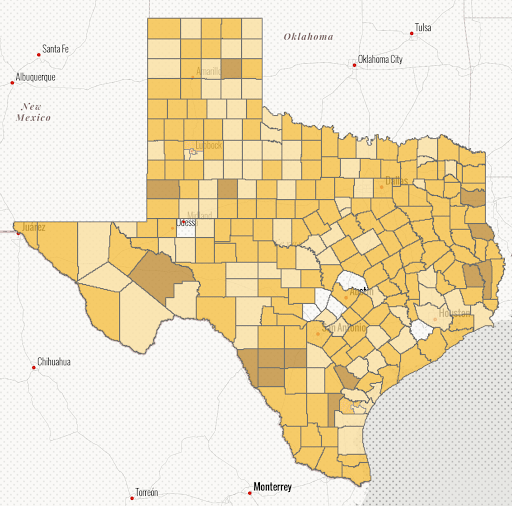What is the state of mental health in Texas?
This is a preview of our Texas 2036 newsletter where we take a look at the data on the state of mental health in the Lone Star State. To receive this weekly look at our work, sign up here.
Mental Health in Texas: What you need to know

Texas 2036 is honored to be in our fourth year as the official data partner of the Texas Lyceum, which is holding its public conference on The State of Mental Health in Texas in Abilene this week.
Below we spotlight key data on how mental health is affecting Texans and what the Legislature is doing to better deploy state resources.
But first, what is mental illness?
Mental illnesses are discrete and treatable health conditions involving functional impairment related to thinking, emotion, or behavior.
Examples of mental illnesses include anxiety, depression, post-traumatic stress disorder, schizophrenia and other psychotic disorders.
What’s the state of mental health in Texas?

One in five adults in Texas experience a mental health condition each year, according to the Substance Abuse and Mental Health Services Administration.
🧒 Two million of 5.2 million Texas children/youth (ages 6-17) –– 35% of the youth population –– had a mental health need in 2022, reports the Meadows Mental Health Policy Institute.
Like in many states, mental illness is not yet detected and treated — to the extent it is detected and treated at all — until 8 to 10 years after symptoms first emerge, according to the American Academy of Child and Adolescent Psychiatry.
Mental illness is an illness of childhood

Half of all mental health conditions manifest by age 14, per mental health survey data.
The Meadows Institute reports one in three Texas children experience a mental health disorder in a given year.
The Meadows Institute President and CEO Andy Keller told Texas legislators last week at the Senate Health and Human Services Committee that children and youth are not treated until a decade after mental health needs emerge.
“Our system was not designed to find children in time. Seventy-five percent of mental health needs will emerge before our brains finish developing in our early twenties,” Keller said.
Did you know?
🩺 75% of children with mental health issues who receive care today are treated in a primary care setting.
🧠 61% of children with depression receive no treatment, according to the National Institute for Mental Health.
🏫 60% of youth who receive mental health care begin receiving services through school, according to the American Psychiatric Association.
Texas schools: Addressing mental health needs

In recent years, the Texas Legislature has worked to provide school districts with the mental health resources to connect families to care.
Texas Child Health Access Through Telemedicine, which provides telemedicine or telehealth programs to school districts at the direction of parents, is currently available on 6,611 school campuses, covering more than 4 million Texas students.
What does TCHATT do? It helps identify and assess the behavioral health needs of children and adolescents and provide access to mental health services.
 Source: www.tcmhcc.utsystem.edu/tchatt/
Source: www.tcmhcc.utsystem.edu/tchatt/
Mental illness and the Texas justice system

Texas jails and emergency rooms are filled with people who have lived with untreated mental illness for years, often cycling in and out of the justice system.
It is estimated that 34% of the inmate population in Texas have mental health disorders, according to the Meadows Institute.

The Meadows Institute reports approximately 70% of youth in the juvenile justice system have a diagnosable mental health disorder.
Of those youth, over 60% also suffer a substance abuse disorder; and 27% have serious disorders that require immediate and significant treatment.
The cost of mental illness in Texas jails
- $450 million in Texas county jail costs for individuals with mental illness.
- $230 million in juvenile justice costs for youth with serious emotional disturbances.
Source: Meadows Institute and the Texas Conference of Urban Counties.
Mental illness has taken the lives of many Texans

There were 4,368 lives lost to suicide in Texas in 2022, according to the Centers for Disease Control and Prevention’s National Center for Health Statistics.
In 2021, 12.3% of Texas high school students attempted suicide in the past year. Suicide is the second leading cause of death among youth ages 10-24, the CDC reports.
How mental health care ties into Texas’ uninsured
According to Texas 2036’s “Who Are the Uninsured?” study, 34% of uninsured individuals postponed obtaining mental health care support, and 37% postponed mental health care support for their children.

Watch Texas 2036 Director of Health and Economic Mobility Policy Charles Miller dive in further on Texas’ uninsured population and mental health care.
A shortage of mental health professionals in Texas
According to the Texas Department of State Health Services, 246 of 254 Texas counties are Mental Health Professional Shortage Areas (MHPSAs).
There was one mental health worker for every 760 residents in 2023, according to Mental Health America’s Access to Care Data report.

Texas Legislature: Addressing mental health needs
The 88th Legislature delivered a record $11.68 billion for behavioral health, an increase of more than 30% from the previous session.
Leading up to the 88th legislative session, policymakers shared a strong resolve to do more for mental health in Texas, and state leadership made it a session priority.
 Source: https://mmhpi.org/topics/policy-research/texas-behavioral-health-rankings/
Source: https://mmhpi.org/topics/policy-research/texas-behavioral-health-rankings/
Mental health resources
If you or someone you know are faced with a mental health crisis, contact one of the following helplines.
- 988 Suicide and Crisis Lifeline: Call or text 9-8-8.
- 2-1-1 Texas: Call or text 2-1-1 or visit 2-1-1 Texas site.
- Crisis Text Line: Text 741741 (Available 24/7).
- Texas Youth Helpline: Call or text 1-855-882-6640.
- Mental Health Texas: Visit mentalhealthtx.org.
Do today’s youth have it tougher when it comes to mental health challenges?

Let us know in our online survey!
